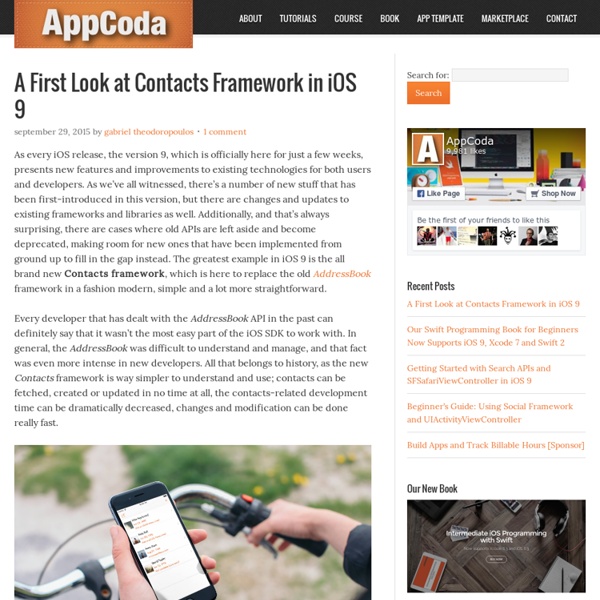



PHP: The Right Way erica/iOS-5-Cookbook Revisiting the App Launch Sequence on iOS In June 2011, I blogged about the App Launch Sequence on iOS for the first time, illustrating what really happens under the hood between the launch of an iOS app and the application:didFinishLaunchingWithOptions: method. Since that time, Apple has revised the default launch sequence in their iOS app project templates, so it is time for an update to the original post. Flowchart of the default app launch sequence in iOS as of Xcode 4.2 for a non-storyboarded app. Feel free to share this image under a Creative Commons Attribution license (CC-BY). Let’s have a look at the changes to the main() function, which still is the starting point for our app. main() uses the new @autoreleasepool { } syntax introduced with LLVM 3.0, but that change doesn’t concern the app’s launch sequence. Looking at the documentation, we learn that the fourth argument to UIApplicationMain() specifies Before Xcode 4.2, all default project templates did create a MainWindow.xib file.
TechCrunch PythonBooks - Learn Python the easy way ! Make iPad Icons Home > Tutorials > Make iPad icons In this topic, we'll learn how to create icons for iPad applications. The topic is based on the Apple article named "iPad Human Interface Guidelines: Creating Custom Icons and Images". Click here to read the original document. Introduction The Apple iPad device defines new standards in personal application development. If you want to create an application for the iPad, you need to create several required and optional icons. In addition, some applications need custom icons to represent custom document types or application-specific functions and modes in navigation bars, toolbars, and tab bars. iPad Icons Criteria The following table contains a summary of information about these icons and images and provides links to specific guidelines for creating them: For all icons and images, the PNG format is recommended. Top of Page Application Icons An application icon is an icon users put on their Home screens and tap to start an application. 72 x 72 pixels 1. 2. 3.
Learn Sketch 3 - Design+Code Sketch is a vector design tool entirely focused on user interface design. It’s easy to pick up and costs a fraction of the price of Photoshop. Because of its simplicity, anyone with little to no training can learn Sketch. It’s perfect for designing for multiple devices, and delivering assets is a breeze. Sketch uses a single unit, styles only relevant to UI design, a built-in iPhone previewing tool called Mirror and Artboards, the most efficient way to design multiple screens. It's been 3 years since I’ve used Sketch exclusively and it has completely changed my workflow. Sketch was voted App of the Year by NetAwards, and most used Wireframing and User Interface Design tool on a survey responded by 4,000 designers, dethroning the almighty Photoshop. Introduction to Sketch Sketch is the ultimate tool for iOS, Android and Web design. Designing for Screens Everything you'll learn in Sketch will immediately be useful to app design. Customizing Your Toolbar Artboards Pages UI Templates Colors Symbols
Table of Contents - Mixu's Node book - Mixu's Node book Launching Your Own Application via a Custom URL Scheme Note: Since the introduction of custom URL schemes, this post has consistently been the top read content on the blog. Although much is the same, there are a few nuances that have changed. This is a re-write of the original post, updated for the latest iOS and Xcode versions. One of the coolest features of the iPhone/iOS SDK is an application’s ability to “bind” itself to a custom URL scheme and for that scheme to be used to launch the application from either a browser or from another application. Registering a Custom URL Scheme The first step is to create a custom URL scheme – start by locating and clicking on the project info.plist in the Xcode Project Navigator. From the list presented scroll down and select URL types. Open the directional arrow and you’ll see Item 0, a dictionary entry. Tap on Item 0 and add a new row, select URL Schemes from the drop-down and tap Enter to complete the row insert. Expand the array and tap on Item 0. Calling Custom URL Scheme from Safari
SSH tricks Why SSH? As recently as a 2001, it was not uncommon to log in to a remote Unix system using telnet. Telnet is just above netcat in protocol sophistication, which means that passwords were sent in the clear. As wifi proliferated, telnet went from security nuissance to security disaster. As an undergrad, I remember running ethereal (now wireshark) in the school commons area, snagging about a dozen root passwords in an hour. SSH, which encrypts and authenticates connections, had been in development since 1995, but it seemed to become adopted nearly universally and almost overnight around 2002. It is worth configuring SSH properly: per-user configuration is in ~/.ssh/config; system-wide client configuration is in /etc/ssh/ssh_config. Key-based, passwordless authentication Key-based passwordless authentication makes it less cumbersome for other programs and scripts to piggyback atop SSH, since you won't have to re-enter your password each time. To set this up, first log in to the client machine.